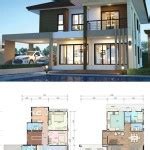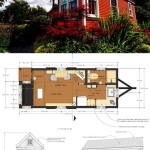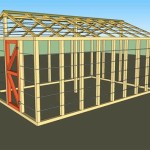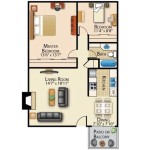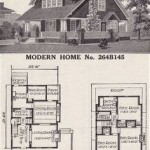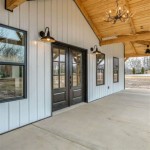Midcentury house plans are architectural blueprints specifically designed for homes built between the 1930s and 1960s. These plans embody the modern design principles that emerged during this period, characterized by simple lines, open floor plans, and an emphasis on natural light. One well-known example of a midcentury house plan is the “Case Study House No. 8” by Charles Eames, which epitomized the movement’s embrace of prefabrication and indoor-outdoor living.
Midcentury house plans have gained renewed popularity in recent years due to their timeless appeal and adaptability to contemporary lifestyles. They often feature large windows that bring the outdoors in, creating a sense of spaciousness and connection to nature. The open floor plans allow for fluid movement and easy entertaining, while the minimalist designs minimize clutter and promote a sense of tranquility.
In this article, we will delve into the defining characteristics of midcentury house plans, explore their historical origins, and showcase some of the most iconic examples that continue to inspire architects and homeowners today.
Midcentury house plans are characterized by a number of key features, including:
- Simple lines
- Open floor plans
- Emphasis on natural light
- Large windows
- Indoor-outdoor living
- Minimalist designs
- Flat roofs
- Carports
- Atriums
These features combine to create homes that are both stylish and functional, and that reflect the optimistic and forward-looking spirit of the midcentury era.
Simple lines
One of the defining characteristics of midcentury house plans is their use of simple lines. This is evident in both the exterior and interior design of these homes. On the exterior, midcentury houses often feature clean lines and geometric shapes, with little ornamentation or detailing. This creates a sleek and modern look that is both timeless and stylish.
Inside, midcentury houses also make use of simple lines. Walls are often unadorned, and windows and doorways are typically rectangular or square. This creates a sense of spaciousness and openness, and allows the natural light to flow freely throughout the home.
The use of simple lines in midcentury house plans is not only aesthetically pleasing, but also functional. Simple lines are easier to clean and maintain than more ornate designs, and they can help to create a more streamlined and efficient living space.
Overall, the use of simple lines is one of the key features that defines midcentury house plans. This design element creates homes that are both stylish and functional, and that reflect the optimistic and forward-looking spirit of the midcentury era.
Open floor plans
Another defining characteristic of midcentury house plans is their use of open floor plans. This means that the traditional walls between the living room, dining room, and kitchen are removed, creating one large, open space. This design concept was revolutionary at the time, and it remains popular today for its many advantages.
Open floor plans create a sense of spaciousness and openness, and they allow the natural light to flow freely throughout the home. This makes them ideal for entertaining guests or simply relaxing with family. Open floor plans also promote a more casual and informal lifestyle, as they encourage interaction and communication between family members.
In addition to their aesthetic and social benefits, open floor plans also have several practical advantages. They are easier to clean and maintain than homes with traditional floor plans, and they can be more energy-efficient, as they require less heating and cooling. Open floor plans also allow for more flexibility in furniture placement, as there are no walls to restrict your options.
Overall, open floor plans are a key feature of midcentury house plans. They create homes that are both stylish and functional, and that reflect the optimistic and forward-looking spirit of the midcentury era.
Emphasis on natural light
Midcentury house plans place a strong emphasis on natural light. This is evident in the large windows that are often used in these homes, as well as the use of skylights and atriums. Natural light has many benefits, both for our physical and mental health. It can help to improve our mood, boost our energy levels, and increase our productivity. Natural light can also help to reduce stress and anxiety, and it can even improve our sleep quality.
In addition to its health benefits, natural light can also make our homes more beautiful and inviting. It can create a sense of spaciousness and openness, and it can help to highlight the architectural features of a home. Natural light can also be used to create dramatic effects, such as by casting shadows or creating reflections.
There are many ways to incorporate natural light into a midcentury house plan. One popular method is to use large windows. Windows can be placed on all sides of a home, and they can be used to frame views of the outdoors. Another way to incorporate natural light is to use skylights. Skylights are windows that are installed in the roof of a home. They can be used to bring light into dark areas of a home, such as hallways or bathrooms.
Atriums are another way to incorporate natural light into a midcentury house plan. Atriums are open spaces that are surrounded by windows. They can be used to create a sense of indoor-outdoor living, and they can help to bring natural light into the heart of a home.
Large windows
Large windows are a defining feature of midcentury house plans. They allow natural light to flood into the home, creating a sense of spaciousness and openness. Large windows also provide views of the outdoors, which can help to connect the home to its surroundings.
There are many benefits to using large windows in midcentury house plans. First, large windows can help to reduce the need for artificial lighting, which can save energy. Second, large windows can help to improve indoor air quality by allowing fresh air to circulate. Third, large windows can provide views of nature, which can have a positive impact on our mental and physical health.
When designing a midcentury house plan with large windows, there are a few things to keep in mind. First, it is important to consider the orientation of the home. The best way to take advantage of natural light is to place large windows on the south-facing side of the home. Second, it is important to choose the right type of windows. There are many different types of windows available, so it is important to choose windows that are appropriate for the climate and style of the home.
- Large windows can help to reduce the need for artificial lighting.
This is because natural light is much brighter than artificial light. By using large windows, you can reduce the amount of time that you need to use artificial lighting, which can save you money on your energy bills.
- Large windows can help to improve indoor air quality.
This is because natural ventilation helps to circulate fresh air throughout the home. When fresh air circulates, it helps to remove pollutants and toxins from the air, which can improve your health and well-being.
- Large windows can provide views of nature.
Studies have shown that spending time in nature can have a positive impact on our mental and physical health. By providing views of nature, large windows can help to reduce stress, improve mood, and boost creativity.
- Large windows can make a home feel more spacious and open.
This is because natural light can make a room feel larger than it actually is. By using large windows, you can create a more spacious and inviting living space.
Overall, large windows are a great way to add style and function to a midcentury house plan. They can help to reduce energy costs, improve indoor air quality, provide views of nature, and make a home feel more spacious and open.
Indoor-outdoor living
Indoor-outdoor living is a key concept in midcentury house plans. This concept is characterized by the seamless integration of indoor and outdoor spaces, creating a home that is both comfortable and stylish.
There are many ways to achieve indoor-outdoor living in a midcentury house plan. One popular method is to use large windows and sliding glass doors. These elements can be used to create a visual connection between the indoors and outdoors, and they can also be used to physically connect the two spaces. Another way to achieve indoor-outdoor living is to use patios, decks, and balconies. These outdoor spaces can be used to extend the living space of the home, and they can also be used to create a private oasis for relaxation and entertaining.
Indoor-outdoor living has many benefits. One benefit is that it can help to reduce stress and improve mental health. Spending time in nature has been shown to have a positive impact on our mood, and it can also help to reduce stress and anxiety. By bringing the outdoors in, we can create a home that is more relaxing and inviting.
Another benefit of indoor-outdoor living is that it can help to save energy. By using natural light and ventilation, we can reduce the need for artificial lighting and heating and cooling. This can lead to significant savings on energy costs.
Overall, indoor-outdoor living is a key concept in midcentury house plans. This concept can help to create homes that are both stylish and functional, and that provide a number of benefits for our health and well-being.
Minimalist designs
Minimalist designs are a key feature of midcentury house plans. This design aesthetic is characterized by its simplicity, functionality, and lack of ornamentation. Minimalist homes are designed to be efficient and easy to maintain, and they often feature open floor plans and clean lines.
There are many benefits to using minimalist designs in midcentury house plans. First, minimalist homes are more affordable to build and maintain than homes with more complex designs. Second, minimalist homes are more energy-efficient, as they require less heating and cooling. Third, minimalist homes are easier to clean and declutter, which can save you time and stress.
If you are considering building a midcentury house, there are a few things to keep in mind when it comes to minimalist design. First, it is important to choose furniture and dcor that is simple and functional. Second, it is important to avoid clutter and unnecessary items. Third, it is important to use natural materials and colors to create a warm and inviting space.
Overall, minimalist designs are a great way to create a stylish and functional midcentury home. By following the tips above, you can create a home that is both beautiful and easy to live in.
Flat roofs
Flat roofs are a defining feature of many midcentury house plans. They are characterized by their simple, clean lines and their lack of a traditional pitched roof. Flat roofs were popularized in the midcentury era due to their modern aesthetic and their ability to provide additional living space.
There are many benefits to using a flat roof in a midcentury house plan. First, flat roofs are more affordable to build than pitched roofs. This is because flat roofs require less materials and labor to construct. Second, flat roofs are more energy-efficient than pitched roofs. This is because flat roofs have a smaller surface area, which reduces heat loss. Third, flat roofs can be used to create additional living space. This is because flat roofs can be used as patios, decks, or even gardens.
However, there are also some drawbacks to using a flat roof in a midcentury house plan. First, flat roofs are more susceptible to leaks than pitched roofs. This is because water can pool on a flat roof, which can lead to leaks. Second, flat roofs can be more difficult to maintain than pitched roofs. This is because flat roofs need to be to prevent debris from accumulating.
Overall, flat roofs are a good option for midcentury house plans. They are affordable, energy-efficient, and can provide additional living space. However, it is important to be aware of the potential drawbacks of flat roofs before making a decision.
Carports
Carports are a common feature in midcentury house plans. They are a type of covered parking that is attached to the house. Carports provide protection from the elements for your car, and they can also be used as an outdoor living space.
There are many benefits to having a carport. First, carports protect your car from the sun, rain, snow, and hail. This can help to extend the life of your car and protect it from damage. Second, carports can provide additional storage space. You can use your carport to store your lawn equipment, bikes, or other items.
Third, carports can be used as an outdoor living space. You can add a patio or deck to your carport, and use it as a place to relax or entertain guests. Carports can also be used as a covered play area for children.
If you are considering building a midcentury house, a carport is a great option to consider. Carports are affordable, functional, and can add value to your home.
Atriums
Atriums are a defining feature of many midcentury house plans. They are open spaces that are surrounded by windows. Atriums can be used to create a sense of indoor-outdoor living, and they can help to bring natural light into the heart of a home.
There are many benefits to having an atrium in a midcentury house plan. First, atriums can help to reduce the need for artificial lighting. This is because natural light can flood into an atrium, even on cloudy days. Second, atriums can help to improve indoor air quality. This is because the plants that are often placed in atriums help to filter the air.
Third, atriums can provide a sense of privacy. This is because the windows in an atrium are often placed high up on the walls, which prevents people from seeing into the home. Fourth, atriums can be used as an additional living space. This is because atriums can be used to create a variety of different spaces, such as a living room, dining room, or even a library.
Overall, atriums are a great way to add style and function to a midcentury house plan. They can help to reduce the need for artificial lighting, improve indoor air quality, provide a sense of privacy, and create additional living space.










Related Posts

